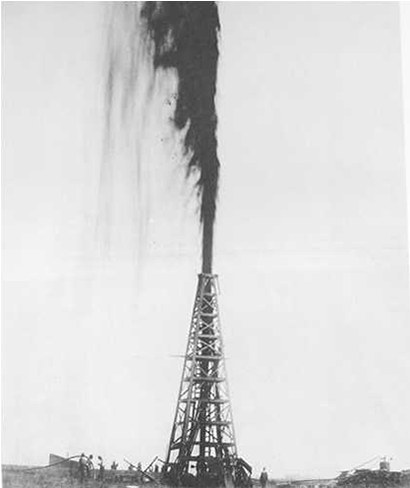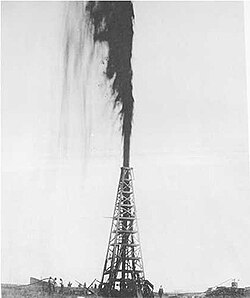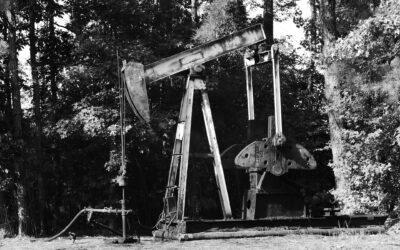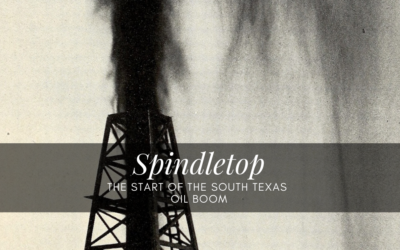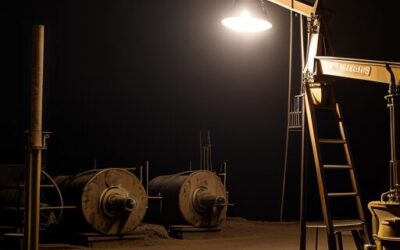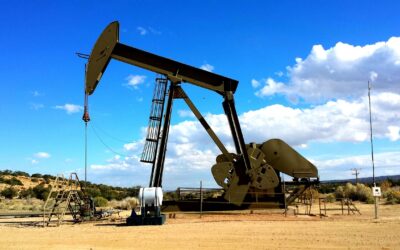Spindletop
Spindletop | |
The Lucas gusher at Spindletop, January 10, 1901. This was the first major gusher of the Texas Oil Boom. | |
| Location | Spindletop Hill, south of Beaumont, Texas, US |
|---|---|
| Coordinates | 30°1′9″N 94°4′26″WCoordinates: 30°1′9″N 94°4′26″W |
| Built | 1900 |
| NRHP Reference # | 66000818 |
| Significant dates | |
| Added to NRHP | November 13, 1966 |
| Designated NHL | November 13, 1966 |
Spindletop is a salt dome oil field located in the southern portion of Beaumont, Texas in the United States. The Spindletop dome was derived from the Louann Salt evaporite layer of the Jurassic geologic period.[1] On January 10, 1901, a well at Spindletop struck oil (“came in”). The Spindletop gusher blew for nine days at a rate estimated at 100,000 barrels (16,000 m3) of oil per day.[2]Gulf Oil and Texaco, now part of Chevron Corporation, were formed to develop production at Spindletop.[3]
The frenzy of oil exploration and the economic development it generated in the state became known as the Texas oil boom. The United States soon became the world’s leading oil producer.
History
There has been oil around Texas for a long time. Native Americans thought drinking oil would cure digestive problems. In 1543, Spanish explorers used oil to waterproof their boots.
There had long been suspicions that oil might be under “Spindletop Hill.” The area was known for its vast sulfur springs and bubbling gas seepages that would ignite if lit. In August 1892, George W. O’Brien, George W. Carroll, Pattillo Higgins and others formed the Gladys City Oil, Gas, and Manufacturing Company to do exploratory drilling on Spindletop Hill. The company drilled many dry holes and ran into trouble, as investors began to balk at pouring more money into drilling with no oil to show for it.
Pattillo Higgins left the company and teamed with Captain Anthony F. Lucas, the leading expert in the U.S. on salt dome formations. Lucas made a lease agreement in 1899 with the Gladys City Company and a subsequent agreement with Higgins. Lucas drilled to 575 feet (180 m) before running out of money. He secured additional funding from John H. Galey and James M. Guffey of Pittsburgh, but the deal left Lucas with only an eighth share of the lease and Higgins with nothing.[4]
Lucas continued drilling and on January 10, 1901, at a depth of 1,139 ft (347 m), what is known as the Lucas Gusher or the Lucas Geyser blew oil over 150 feet (50 m) in the air at a rate of 100,000 barrels per day (16,000 m3/d)(4,200,000 gallons). It took nine days before the well was brought under control.[2]
Spindletop was the largest gusher the world had seen and catapulted Beaumont into an oil-fueled boomtown. Beaumont’s population of 10,000 tripled in three months and eventually rose to 50,000.[5] Speculation led land prices to increase rapidly. By the end of 1902, more than 500 companies had been formed and 285 wells were in operation.[2]
Spindletop was the first oilfield found on the US Gulf Coast, and prompted further drilling, and further oil field discoveries. Oil drillers looking for another Spindletop particularly sought out other salt domes, and were often successful. The Gulf Coast turned into a major oil region.
Standard Oil, which then had a monopoly or near-monopoly on the petroleum industry in the eastern states, was prevented from moving aggressively into the new oilfield by state antitrust laws. Populist sentiment against Standard Oil was particularly strong at the time of the Spindletop discovery. In 1900, an oil products marketing company affiliated with Standard Oil had been banned from the state for its cutthroat business practices. Although Standard built refineries in the area, Standard was unable to dominate the new Gulf Coast oil fields the way it had in the eastern states. As a result, a number of startup oil companies at Spindletop, such as Texaco and Gulf Oil, grew into formidable competitors to Standard Oil.[6]
Among those drilling at Spindletop was W. Scott Heywood, a native of Cleveland, Ohio, who in 1901 made the first oil discovery in nearby Jeff Davis Parish in southwestern Louisiana. In 1932, Heywood was elected to a single term in the Louisiana State Senate.[7]
Production at Spindletop began to decline rapidly after 1902, and the wells produced only 10,000 barrels per day (1,600 m3/d) by 1904.[2] On November 14, 1925, the Yount-Lee Oil Company brought in its McFaddin No. 2 at a depth of about 2,500 feet (800 m), sparking a second boom, which culminated in the field’s peak production year of 1927, during which 21 million barrels (3.3 GL) were produced.[2] Over the ten years following the McFaddin discovery, more than 72 million barrels (11.4 GL) of oil were produced, mostly from the newer areas of the field. Spindletop continued as a productive source of oil until about 1936. It was then mined for sulfur from the 1950s to about 1975.
Spindletop-Gladys City Boomtown Museum
In 1976 Lamar University dedicated the Spindletop-Gladys City Boomtown Museum to preserve the history of the Spindletop oil gusher era in Beaumont. The museum features an oil derrick and many reconstructed Gladys City building interiors furnished with authentic artifacts from the Spindletop boomtown period.[8]
The Lucas Gusher Monument is located at the museum. The Monument, erected at the wellhead in July, 1941, was moved to the Spindletop-Gladys City Museum after it became unstable due to ground subsidence. According to an article by Nedra Foster, LS in the July/August, 2000 issue of the Professional Surveyor Magazine, the Monument was originally located within four feet of the site of the Spindletop well.[9]
Today the wellhead is marked at Spindletop Park by a flagpole flying the Texas flag. It is located about 1.5 miles southwest of the museum, off West Port Arthur Road/Spur 93. The site includes a viewing platform with information placards, about a quarter mile from the flagpole. The wellhead site is in the middle of swampland on private land and is not accessible. Directions to the park and viewing platform are available at the museum.
On December 4, 1955, the Spindletop story was dramatized in “Spindletop – The First Great Texas Oil Strike (January 10, 1901)” on the CBS history series, You Are There. Robert Bray was cast as Pattillo Higgins; Mike Ragan as Marion Fletcher; Parley Baer as Captain Lucas, Jean Byron as Caroline Lucas, DeForest Kelley as Al Hammill, Tyler McVey as Mayor Wheat, and William Fawcett as a farmer.[10]
References
- Hyne, Norman J., Nontechnical guide to petroleum geology, exploration, drilling, and production, Pennwell Books, 2nd ed. p. 193 ISBN 978-0-87814-823-3
- Wooster, Robert; Sanders, Christine Moor: Spindletop Oilfield from the Handbook of Texas Online. Retrieved October 18, 2009., Texas State Historical Association
- Daniel Yergin, The Prize, New York: Simon & Schuster, 1991, pp.75–78.
- Daniel Yergin, The Prize, New York: Simon & Schuster, 1991, p.75.
- Daniel Yergin, The Prize, New York: Simon & Schuster, 1991, p.69.
- Ron Chernow, Titan: the Life of John D. Rockefeller {New York: Random House, 1998} 431.
- “Heywood, Walter Scott”. Louisiana Historical Association, A Dictionary of Louisiana Biography. Retrieved January 30, 2011.
- http://www.spindletop.org/tour/index.html
- 1
- “Spindletop – The First Great Texas Oil Strike (January 10, 1901)(4 Dec. 1955), You Are There“. Internet Movie Data Base. Retrieved April 20, 2014.
- McKinley, Fred B., and Greg Riley. Black Gold to Bluegrass: From the Oil Fields of Texas to Spindletop Farm of Kentucky, historical non-fiction, Austin: Eakin Press, 2005, ISBN 1-4241-7751-0
